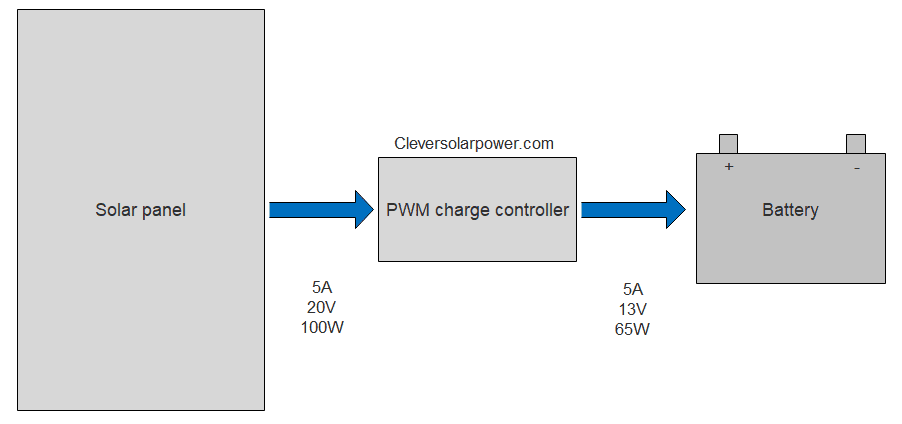Solar charge controllers are responsible for regulating the voltage and current coming from solar panels to the batteries. They ensure that the batteries are correctly charged without being overcharged or over-discharged, which can damage the batteries and reduce their lifespan.
There are two main types of solar charge controllers:
- Pulse Width Modulation (PWM)
- Maximum Power Point Tracking (MPPT)
Let’s dive deeper into how these charge controllers work. It can get technical.
PWM Charge Controllers
PWM charge controllers are the simpler and more affordable option. They work by slowly reducing the power applied to the batteries as they approach full charge. This helps maintain the battery voltage at a safe level.
PWM controllers are best suited for smaller solar systems with a solar panel voltage closely matching the battery voltage.
However, they are less efficient than MPPT controllers, especially when the solar panel voltage is significantly higher than the battery voltage.
Read my expert article on the best PWM solar charge controllers.
How Does the PWM Charge Controller Work?
PWM stands for Pulse Width Modulation. This type of charge controller serves as an electrical switch that directly connects the solar array and the batteries.
The switch can open and close at specific intervals according to the battery’s charging requirements. This happens very fast. The faster it switches, the more energy is allowed to go to the battery (higher duty cycle). If the duty cycle is lower, less energy is sent to the battery.
Adjusting the duty cycle can adjust the voltage to match the battery.

When the switch is closed (on), the voltage in the PV array will match the battery’s voltage.
The diagram below shows that the voltage gets lowered to match the battery voltage, but the current stays the same. This is because the PWM doesn’t adjust the current.

In short: A PWM charge controller is a fast on-and-off switch. It is not a DC-DC converter.
If you have a 36V solar panel and a 12V battery, 2/3 of the voltage gets wasted because the PWM controller doesn’t reduce the voltage. Read my article about the PWM charge controller efficiency.
With a PWM charge controller, you must closely match the solar panel voltage to the battery bank voltage.
MPPT Charge Controllers
MPPT charge controllers are more advanced and offer higher efficiency.
They continuously track the maximum power point of the solar panels to ensure that the maximum possible power is extracted at any given time. This results in more efficient energy conversion and faster battery charging.
MPPT controllers can also handle higher voltage solar panel arrays, making them suitable for larger solar systems or when the solar panel voltage is significantly higher than the battery voltage.
They are typically more expensive than PWM controllers, but their improved efficiency can make them a better choice in many situations.
Read my expert article on the best MPPT solar charge controllers
How Does the MPPT Charge Controller Work?
MPPT stands for Maximum PowerPoint Tracking. This type of device has more sophisticated technology, and it’s more efficient.
The MPPT charge controller is a DC-to-DC converter that transforms power from high to low voltage. It tracks the maximum power point that the solar array can produce and balances voltage and current according to the P = V x I equation to always provide the maximum power point to the batteries.

To find and track the MPP, the MPPT controller uses algorithms such as Perturb and Observe (P&O), Incremental Conductance (InC), or Constant Voltage (CV), among others (source).
These algorithms enable the MPPT controller to dynamically adjust the voltage and current levels to optimize power extraction from the solar panels, even under varying environmental conditions, such as changes in sunlight intensity or temperature.
For example, in the Perturb and Observe algorithm, the controller slightly perturbs (changes) the operating voltage and observes the resulting change in power output. If the power output increases, the controller moves the operating point in that direction.
If the power output decreases, it moves in the opposite direction. The controller continuously adjusts the operating point to maintain the maximum power output under varying conditions.
Here is a flowchart of the perturb and observe algorithm for interested readers.

Now, let’s get back to human language.
The diagram below shows that the voltage will match the battery bank, but the current will increase. This is because the MPPT converts the excess voltage to more current.

Unlike the PWM controller, an MPPT controller separates the array’s voltage from the voltage of the battery.
In other words, the solar system could have a 12V battery on the output of the MPPT charge controller and simultaneously have modules wired in series producing 36V on the input side. The MPPT will convert the 36V and increase the current going into the battery.
If you want to read more about a PWM vs MPPT charge controller, read my article here.
[custom-related-posts title=”Related Posts” none_text=”None found” order_by=”title” order=”ASC”]
I’m an off-grid enthusiast. I created this website to give clear and straight-to-the-point advice about solar power. I’m also the author of the book ‘Off-grid solar power simplified‘. Read more about me on my about page, check out my Youtube channel, or send me a message.
Very informative, excellent read, lots of good design case studies. I strongly recommend this book for anyone wanting to improve your knowledge and design off your off grid solar system.
Thank you Brad!